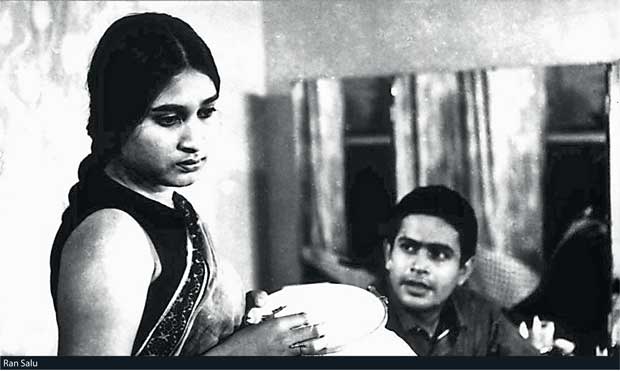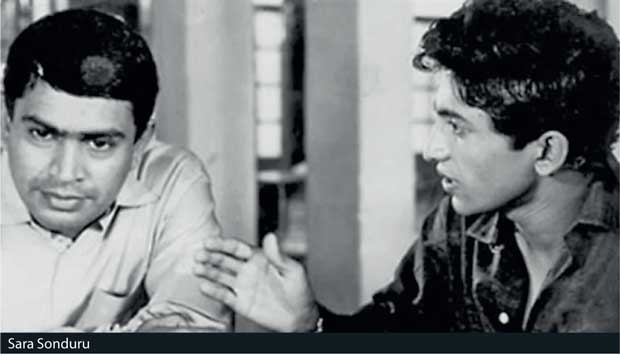Reply To:
Name - Reply Comment
Last Updated : 2024-05-11 03:39:00

 The English have a wonderful dramatic tradition, the Americans a wonderful movie tradition. Both are more or less reflected in the styles of acting they popularise: the English with Shakespeare, Marlowe and Laurence Olivier, the Americans with Stella Adler, Lee Strasberg and Elia Kazan. When an individual actor professes interest in either of these, he does so while rejecting the other, which is why the English are still averse to the Method and the Americans still covertly disdainful of Shakespeare.
The English have a wonderful dramatic tradition, the Americans a wonderful movie tradition. Both are more or less reflected in the styles of acting they popularise: the English with Shakespeare, Marlowe and Laurence Olivier, the Americans with Stella Adler, Lee Strasberg and Elia Kazan. When an individual actor professes interest in either of these, he does so while rejecting the other, which is why the English are still averse to the Method and the Americans still covertly disdainful of Shakespeare.
One comes across this even in an individual film or play: Joseph Manciewicz’s Julius Caesar (1953), for instance, has James Mason as Brutus, John Gielgud as Cassius, Greer Garson as Calpurnia, Deborah Kerr as Portia, and Marlon Brando as Mark Antony. The first four were British, while the fifth, as Pauline Kael once memorably described him, was the “contemporary version of the free America.” Cyril Wickremage, whom I met two years ago, and who was influenced by the Method, said he preferred Brando to Mason and Gielgud. Tony Ranasinghe, whom I met a month later, and who was influenced by the English theatre, said he preferred Mason and Gielgud to Brando (As if to justify his position, he added that, in his opinion, Brando deteriorated into an unnecessary parody of himself as the years went by).
Unfulfilled, rejected, dejected, and menacing, Tony Ranasinghe’s characters were hardly the romantic screen personalities his face and his looks would have made you believe him to be

The first great American actors came from the theatre – the Barrymores, Lillian Gish, Emil Jannings – as did the first great American directors – Griffith, Chaplin, right until Orson Welles – but in Sri Lanka, unlike even India, the actors continued for a long time to come from the stage (This is true of today’s actors as well). In its first few years they all derived their emotional power from the Parsi theatre, the nadagama, and the morality plays of Sirisena Wimalaweera. Irangani Serasinghe, who predated Gamini Fonseka and Ranasinghe, proved to be an exception here: as the first Sri Lankan who graduated from the Royal Academy of Dramatic Art, she rooted all her performances in the thespian tradition of fleshed out ordinary characters. Shakespeare was at his best in his tragedies – his comedies touch on tragedy, at least briefly – and tragedy had in Sri Lanka been the preserve of the Minerva Players. With Serasinghe and Ranasinghe, a new form of acting came out, more felt and genuine.
In the movies Ranasinghe was almost always the man who could never fulfil himself, obviously an extension of the roles that Sugathapala de Silva had got him to play with Ape Kattiya. He was never the hero, never the lover, never the husband he wanted so badly to be. As Nissanka Wijesinghe in Delovak Athara (1966), his real onscreen debut, he symbolised an entire generation’s frustration with their elders and peers, and like Dean’s Jim Stark (from Rebel Without a Cause), he clashed with them because he wanted to stay true to his conscience. Irangani had found her definitive, signature role with the mother. Ranasinghe had found his with the frustrated idealist, the sort who dreamt big and spoke loftily but who never was himself when he had to be.
In the movies Ranasinghe was almost always the man who could never fulfil himself

In Ran Salu, as the villain Cyril, for instance, he makes fun of his fiancée’s sense of goodness because she’s the exact opposite of who he is. Having abandoned her for a more sensual friend of hers, Sarojini (Anula Karunatilake), he proceeds to then abandon his second lover for a prettier, wealthier third, who urges him to throw Sarojini out (she bears him a child), marry her, and leave for England. “Seeing you makes me realise how vulgar and common Sara was,” he chortles. And yet, when he confronts Sara at the hospital, he dithers rather guiltily. “I’ve come to say goodbye,” he says, looking down, “I won’t be seeing you again. Ever.” Even as the villain, and a pretty daring one at that (Ran Salu was the first film here that depicted a couple in bed, naked; he was the man, Anula the woman), he can only
stutter awkwardly. And in becoming someone who wasn’t true to himself, he spoke for all of us who wanted to be everyday heroes. Nissanka in Delovak Athara is as ordinary and common as the frustrated lover in Hanthane Kathawa, a role which its director, Sugathapala Senarath Yapa, had written with Tony Ranasinghe in mind. (It goes without saying, naturally, that no other actor could have symbolised the pain and suffering of denied love that he could and did there.) He had rejected the Method, while ironically embodying the one archetype that the Method, and Hollywood in general, perfected and marketed: the Everyman, or the ordinary Average Joe who’s placed in an extraordinary, bewildering situation. He needn’t have been a hero, and he actually isn’t, but in terms of the range of experience and emotion he brings out, he was unparalleled by any hero or villain the mainstream cinema could conjure.
The problem with most teenagers is that they are always idealising themselves so much when their instincts get the better of them, they’re left grappling in the dark
The problem with most teenagers is that they are always idealising themselves so much when their instincts get the better of them, they’re left grappling in the dark. They can be lovers or fighters or cowards and still yearn to be more than they are. Right until Hanthane Kathawa, which signified an end of a decade and an era (it would be followed by the more politically turbulent seventies), these were the kinds of characters that Tony played. The problem with those youngsters as they mature and mellow, on the other hand, is that they are so ashamed of their past freewheeling idealisms that they want to repress, rationalise, and intellectualise. From the seventies to the early nineties, Tony hence revelled in playing out these mellowed youngsters: Suraweera in Duhulu Malak (1976), Bibile Aththo in Hulawali (1976), Sarath in Ahasin Polawata (1979). Earlier he had been conquered by instinct; now he was being conquered, slowly but inevitably, by cold, calculated, unemotional reason.
This was reflected well in his physique. Irangani Serasinghe, like Chaplin and the two Hepburns, had aged gracefully, so she could become kinder, gentler (with the exception of the eighties). Tony, on the other hand, like William Holden, was becoming gruffer, more careless, and more cynical: the messed up hair and the thick eyebrows on Bibile Aththo and Sarath and the father in Maya indicated that he was turning into older versions of the crooners and idealists he had been before.

Those idealists had been denied the privilege of realising themselves because of their idealism; now their older selves were being denied that same privilege because of their rationalism. They had been frustrated lovers; now they were frustrated husbands. Ultimately they all congealed into the same character: impotent, brooding, prone to fits of rage and passion, but never fulfilled. (In Parasathumal he’s a wronged lover who, in one such fit, takes up a gun and walks right through a huge rubber estate to confront the man who stole the woman he loved; halfway through, he’s so spent up by the long walk that he pants, sighs, and returns, bitterly acknowledging defeat).
With Yuganthaya, and as Simon Kabilana, Gamini Fonseka returned to the Sinhala cinema, the same cinema that had threatened to reject him, and in doing so he finally became himself. With Tony Ranasinghe, however, becoming oneself wasn’t really an option, because he was scattered here and there, having played a great many characters and depicting a great many emotions, hopes, fears, sorrows. Despite the tentative comparisons one can draw between, say, the lover in Hanthane Kathawa and the husband in Ahasin Polawata, it’s rather difficult to reconcile his Fernando in Baddegama with the mafia leader in Saptha Kanya or the gentle, caring father in Janelaya. The second of these proved to be so uncharacteristic and atypical that people found it difficult to reconcile the performer to the performance: a feat which won him the Best Actor award from the Sarasavi, Swarna Sanka, OCIC and Presidential ceremonies. To become oneself, one had to be a Brando, a Richard Burton (another actor criticised by Ranasinghe as being deliberately undisciplined), and he was neither: he preferred plurality to singularity, right until his last few roles.
Unfulfilled, rejected, dejected, and menacing, Tony Ranasinghe’s characters were hardly the romantic screen personalities his face and his looks would have made you believe him to be. He subverted the rule that one’s looks were an indicator of one’s likeability in the movies. The truth was that the more he tried to be likeable, the more he was stifled and spurned, to his consternation. Almost always bewildered, and always impotently furious, the man never quite received what he hankered after.
He obviously tried, very hard, to get us to accept the men he wanted to be. When he failed there, he could only grope around in the dark. Marlon Brando was like that too, except that Brando always yelped about his inadequacies, while Tony, who preferred to bottle up, was more cautious. It’s easier to be a hero, after all: easier to be a fighter, a soldier, a saviour. Brando’s saying about being a bum instead of the champ he could have been might have easily applied to Tony. But Tony would never have said it. He would have shielded his insecurity, congealing into the opposite of who he aspired to become and thereby becoming less likeable, and
more complex.
The second of three articles exploring the trinity of our film industry.

Add comment
Comments will be edited (grammar, spelling and slang) and authorized at the discretion of Daily Mirror online. The website also has the right not to publish selected comments.
Reply To:
Name - Reply Comment
US authorities are currently reviewing the manifest of every cargo aboard MV
On March 26, a couple arriving from Thailand was arrested with 88 live animal
According to villagers from Naula-Moragolla out of 105 families 80 can afford
Is the situation in Sri Lanka so grim that locals harbour hope that they coul
7 hours ago
7 hours ago

10 May 2024
09 May 2024
09 May 2024